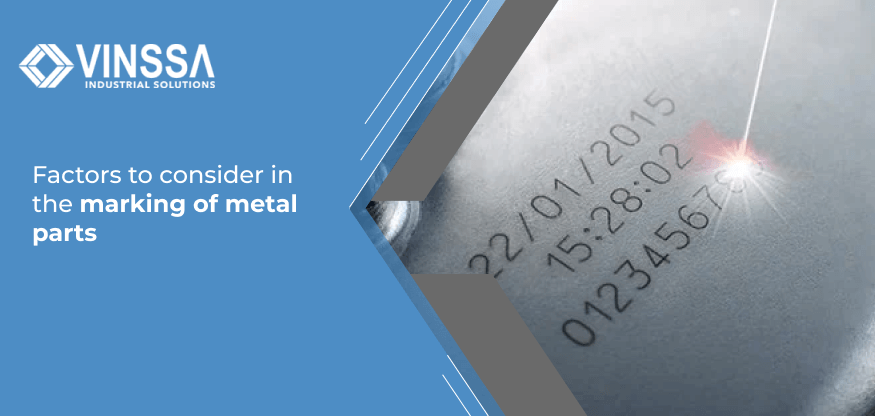Factors to consider when marking metal parts
January 10, 2019 By: Staff Vinssa

Metal marking plays a key role in industries where mass production is essential- automotive, electronics, aerospace, and metalworking.
At VINSSA, we provide both laser and micro-percussion marking solutions for a wide range of metals and applications. Discover the benefits, best practices, and technologies that support coding and identification in your processes.
Content of this article:
Why mark metal parts?
Benefits of marking and traceability in metals
Technologies for marking metal parts
Best practices for marking metal parts
Industries that require traceability in metals
VINSSA your best choice for coding metal parts
Why mark metal parts?
Metal marking is essential for three main purposes:
1. Identification
- Standardizes product labeling
- Indicates manufacturer of supplier.
- Confirms quality inspection and compliance.
- Includes key manufacturing data: part name, serial number, date, machine, and batch.
2. Traceability
- Tracks the part's location and status during production
- Integrates with real-time monitoring and scanning systems (also offered by VINSSA)
- Enables marking of logos, brand names, and custom designs
3. Aesthetics and image
- Enables marking of logos, brand names, and custom designs.
- Strengthens brand visibility and product recognition in the market.
Benefits of metal part marking and traceability in metals
Some advantages of this technology for our customers' processes are:
- Accurate, simple and fast marking: Short cycle times with minimal waste.
- Versatility: Compatible with various metals like copper, aluminum, steel, alloys, etc.
- Brand visibility: Allows easy identification of origin for repairs or technical support.
- easy identification of origin for repairs or technical support.
- Durability: Marks resist heat, chemicals, corrosion, and wear.
- Customization: Solution tailored for any production environment of marking need.
Metal part marking technologies
VINSSA offers advanced technologies for direct and indirect metal marking. Here´s how each method works:
1. Direct on the part
- Ideal for metal using fiber laser technology.
- Silent operation - reduces workplace noise.
- Efficient cycle times depending on mark size and intensity.
- Not recommended if the part will be painted afterward, as the mark may disappear.
- Requires specific safety measures for operator protection.
B) Micropercussion Marking (Dot Peen)
- Marks through a series of pressure-driven dots in a defined area.
- Operates with one or multiple tips of different shapes/masses.
- Compatible with Telesis equipment.
- This type of pneumatic equipment does generate noise.
- It is necessary to have an adequate and safe clamping of the piece.
- More affordable than laser systems.
- Highly effective for markings that must withstand painting, such as on vehicle chassis.
C) Scratching of metal parts (Scribe)
- Functions like micro-percussion but creates continuous lines instead of dots.
- Produces deeper marks, ideal for VINS or serial numbers
- Slightly slower but excellent for durable, readable marks
- Cannot generate 2D codes (unlike laser and dot peen systems)
2. External (indirect) Marking
- Used when surface alteration is not allowed
- Temporary labels or tags that can be removed post-process.
Best practices for marking metal parts
Here are some tips for metal marking:
- Laser Marking: do it on flat, clean surfaces to optimize speed and accuracy.
- Micro-percussion marking: Avoid curved or rough areas to ensure mark quality.
- Scratching of metal parts (Scribe): Use firm, stable fixturing to reduce vibration during marking.
- Labeling: Ideal for temporary identification of when marks must be removed later.
Industries that rely on metal marking
Some of the industries that use our marking systems on a regular basis are:
- Automotive: On every part of the vehicle, engines, chassis, seats, structural parts.
- Electronics: On electronic board, capacitors, enclosures.
- White Goods: Washers, blenders, metal housing and components.
- Aerospace: Every component part of an aircraft such as turbines, metal structures and seats.
- Metalworking: Ingots, bars, steel plates, and industrial assemblies.
Why Choose VINSSA for Metal Part Marking?
At VINSSA we we specialize in industrial identification and traceability solutions, some advantages of choosing us as your supplier are:
- We provide a complete marking and tracking system or a single piece of equipment.
- Texas coverage across key industrial regions.
- Expert support and warranty service for all brands we represent.
- We have a wide range of equipment, solutions and technologies.
Have a project?
Our consultants can help you choose the right equipment based on:- Your productions volumes and cycle times
- The type of metal to be marked
- Equipment location within the process
- Whether you're marking before or after finishing processes (like painting)
 8441124288
8441124288
 844 278 5462
844 278 5462





 844 797 5478
844 797 5478
 sales@vinssa.com
sales@vinssa.com








